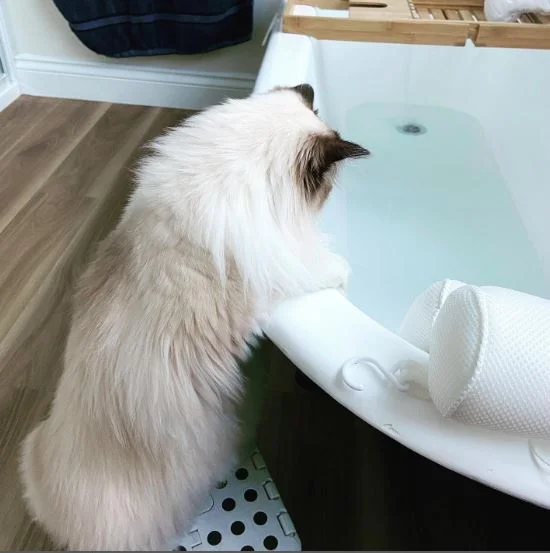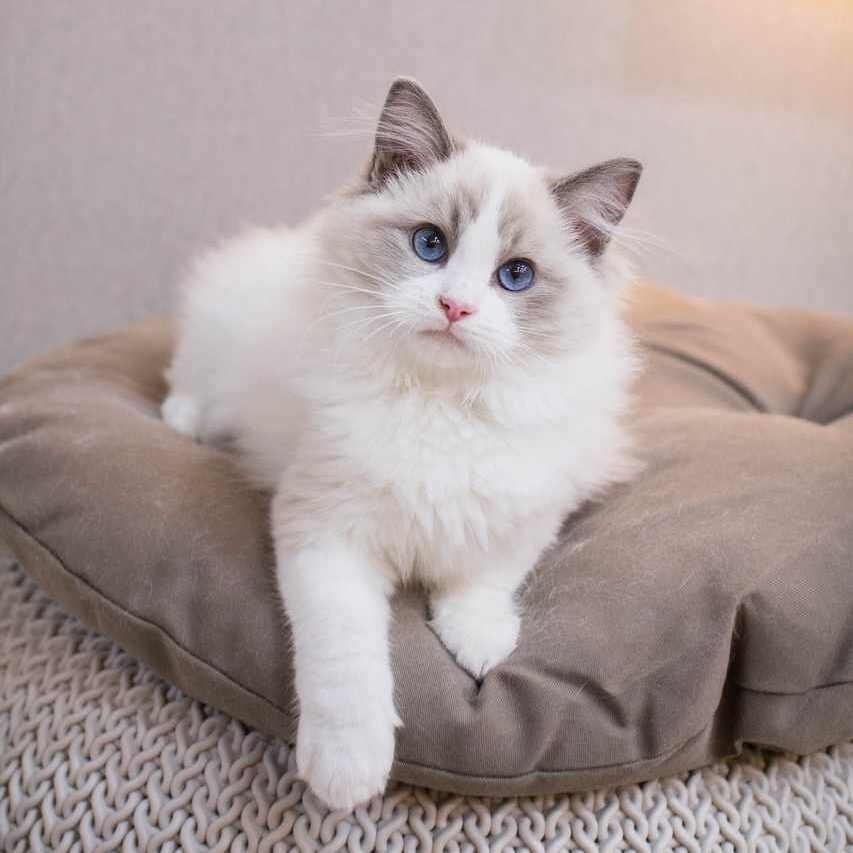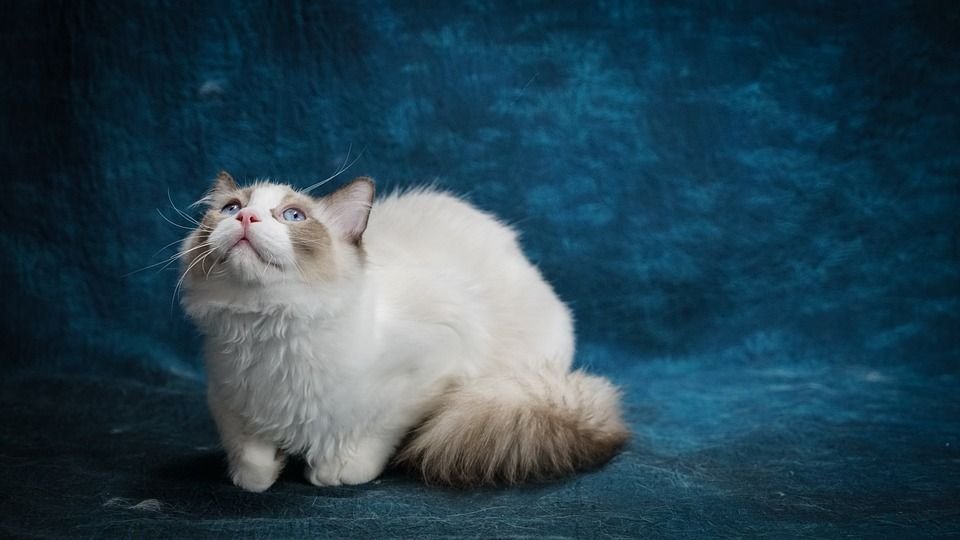If your Ragdoll cat throws up often, it could be due to food sensitivities, stress triggers, or hairballs. These factors can impact their well-being. Make sure to monitor their diet closely, consider high-quality protein options, and stick to a consistent feeding schedule. Regular grooming can help prevent hairballs.
Watch out for signs of more serious health conditions. If the vomiting persists, consult a veterinarian for proper evaluation and treatment. Taking these steps can help address the issue and guarantee your Ragdoll cat stays healthy and happy.
Common Causes of Vomiting in Ragdoll Cats
We often see various reasons for vomiting in Ragdoll cats. Ragdoll cat food sensitivities can trigger episodes of vomiting, especially when they consume foods that don’t agree with their digestive system.
Additionally, stress-induced vomiting in Ragdoll cats isn’t uncommon. Changes in their environment, such as moving to a new home or encountering new pets, can lead to increased stress levels and subsequent bouts of vomiting.
It’s important to monitor your Ragdoll cat’s behavior and environment to identify and address potential stressors.

Dietary Factors to Consider
Considering dietary factors is vital when addressing Ragdoll cat vomiting, as their food sensitivities can trigger episodes of gastrointestinal distress. To minimize vomiting episodes, it’s important to select high-quality protein sources and consider grain-free options, as some Ragdolls may have sensitivities to certain grains.
Additionally, practicing portion control and establishing a consistent feeding schedule can help regulate your cat’s digestion and reduce the likelihood of vomiting. By carefully monitoring your Ragdoll’s diet and ensuring they receive the proper nutrients without overeating, you can potentially prevent gastrointestinal upset.
Making informed choices about protein sources, opting for grain-free alternatives, and implementing portion control strategies are key steps in managing your Ragdoll cat’s dietary needs to minimize vomiting incidents.
Hairballs and Vomiting
Addressing hairballs and vomiting in Ragdoll cats requires understanding the correlation between hair ingestion and gastrointestinal distress. Regular grooming techniques are important in preventing excessive hair accumulation, which can lead to hairballs. Ensuring that your Ragdoll cat’s coat is well-maintained through brushing can help reduce the amount of hair ingested during grooming sessions.
Additionally, digestive issues can contribute to vomiting in Ragdolls, making it vital to monitor their food intake for any signs of food allergies that could be triggering gastrointestinal upset. Furthermore, be cautious with indoor plants, as some can be toxic to cats and may cause vomiting if ingested.

Health Conditions and Vomiting
Health conditions may contribute to vomiting episodes in Ragdoll cats. Certain medical conditions, such as gastrointestinal disorders, kidney disease, and pancreatitis, can lead to frequent vomiting in these cats. It’s important to monitor your Ragdoll cat for warning signs like persistent vomiting, lethargy, and changes in appetite.
If you notice any concerning symptoms, it’s vital to consult with a veterinarian promptly for a thorough evaluation. Treatment for health conditions causing vomiting in Ragdoll cats may include medication, dietary changes, and lifestyle adjustments.
Preventive measures such as regular veterinary check-ups, maintaining a balanced diet, and providing adequate hydration can help reduce the risk of health-related vomiting episodes in Ragdoll cats.
Tips to Prevent Vomiting in Ragdoll Cats
To prevent vomiting in Ragdoll cats, monitoring their diet closely is essential. It’s important to establish consistent feeding habits, providing high-quality cat food that’s appropriate for their age and health needs. Avoid sudden changes in their diet and refrain from giving them table scraps, which can upset their stomach.
Additionally, make sure your Ragdoll cat stays hydrated by providing fresh water at all times. Stress management is also vital in preventing vomiting episodes. Create a calm and peaceful environment for your cat, provide them with a designated space to retreat to, and engage in regular play sessions to help alleviate any anxiety.
Frequently Asked Questions
Can Stress or Anxiety Cause Vomiting in Ragdoll Cats?
Stress or anxiety can indeed lead to vomiting in Ragdoll cats. Dietary changes, behavioral triggers, environmental stressors, and underlying health concerns should all be considered when addressing this issue to safeguard our feline friend’s well-being.
Are There Any Specific Plants That Could Trigger Vomiting in Ragdolls?
When it comes to toxic plants, prevention is key. Knowing which indoor hazards exist can help us take necessary precautions to keep our ragdoll cats safe. Let’s create a pet-friendly environment by being informed.
Is It Normal for Ragdoll Cats to Vomit After Grooming Themselves?
Yes, it’s common for Ragdoll cats to vomit after grooming themselves due to ingested hair. Dietary changes, food allergies, or excessive grooming can also trigger vomiting. Monitoring their grooming habits and diet is essential for their health.
Can Certain Medications Lead to Vomiting in Ragdoll Cats?
Certain medications can lead to vomiting in Ragdoll cats. Always consult your vet before giving any medication to your pet. Some common causes of vomiting in cats can be dietary changes, allergies, environmental factors, or exposure to toxins.
How Can I Tell if My Ragdoll Cat’s Vomiting Is a Sign of a Serious Health Issue?
If our ragdoll cat’s vomiting persists, we observe other symptoms like weight loss, lethargy, or changes in behavior. Dietary changes, food allergies, hairballs, or digestive issues could be culprits, so a vet visit is essential.
Conclusion
So, turns out our precious little ragdoll cats aren’t just graceful fluff balls – they’re also expert hurlers!
From dietary mishaps to hairball dramas, there are plenty of reasons why our feline friends may be tossing their kibble.
Remember, prevention is key, so keep an eye on what they’re munching on, brush them regularly, and schedule those vet check-ups.
Here’s to less clean-up duty and more happy, healthy kitties!

Hey guys, My name is Simon Smith. I’m from Canada and live near Victoria
I live with my sweet family and have 20+ Ragdolls of different types. I love them as my children. My profession is as a hotel manager.
I love to keep Ragdolls and grow their breeder case. I have 7 years of experience.
I’m an expert in cat care. So, I’m here to provide you with new information about my cats daily. This is my blog website, so I request that you kindly visit our site daily.
If you’re a Ragdolls lover and you have any questions or confusion about cats, text me on the Contact Us page or Gmail.
Thank u
